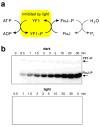Light activation as a method of regulating and studying gene expression
- PMID: 19857985
- PMCID: PMC2787999
- DOI: 10.1016/j.cbpa.2009.09.026
Light activation as a method of regulating and studying gene expression
Abstract
Recently, several advances have been made in the activation and deactivation of gene expression using light. These developments are based on the application of small molecule inducers of gene expression, antisense- or RNA interference-mediated gene silencing, and the photochemical control of proteins regulating gene function. The majority of the examples employ a classical 'caging technology', through the chemical installation of a light-removable protecting group on the biological molecule (small molecule, oligonucleotide, or protein) of interest and rendering it inactive. UV light irradiation then removes the caging group and activates the molecule, enabling control over gene activity with high spatial and temporal resolution.
Figures













References
-
- Casey JP, Blidner RA, Monroe WT. Caged siRNAs for Spatiotemporal Control of Gene Silencing. Mol Pharm. 2009;6:669–685. - PubMed
-
- Young DD, Deiters A. Photochemical control of biological processes. Org Biomol Chem. 2007;5:999–1005. - PubMed
-
- Tang X, Dmochowski IJ. Regulating gene expression with light-activated oligonucleotides. Mol Biosyst. 2007;3:100–110. - PubMed
-
- Mayer G, Heckel A. Biologically active molecules with a “light switch”. Angew Chem Int Ed. 2006;45:4900–4921. - PubMed
-
- Curley K, Lawrence DS. Light-activated proteins. Curr Opin Chem Biol. 1999;3:84–88. - PubMed
Publication types
MeSH terms
Substances
Grants and funding
LinkOut - more resources
Full Text Sources
Other Literature Sources

